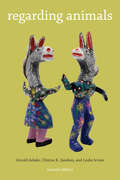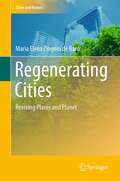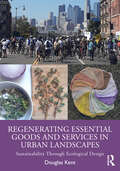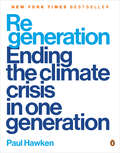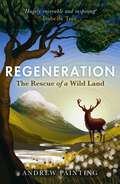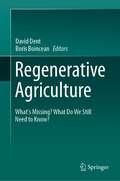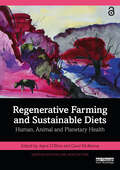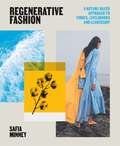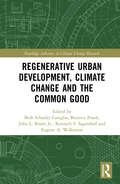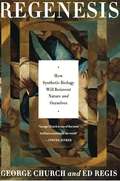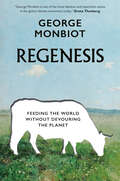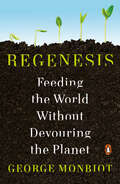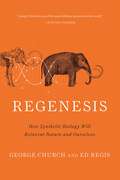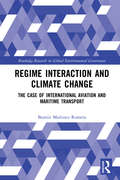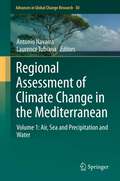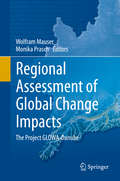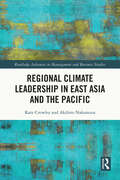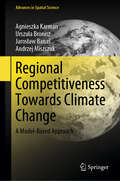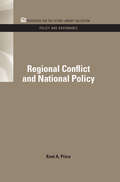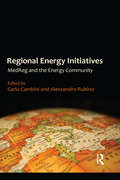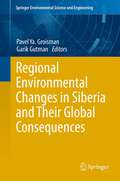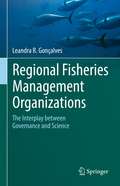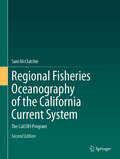- Table View
- List View
Regarding Animals (Animals Culture And Society)
by Arnold Arluke Leslie Irvine Clinton SandersWinner of the Charles Horton Cooley Award, Society for the Study of Symbolic Interaction, 1997 The first edition of Regarding Animals provided insight into the history and practice of how human beings construct animals, and how we construct ourselves and others in relation to them. Considerable progress in how society regards animals has occurred since that time. However, shelters continue to euthanize companion animals, extinction rates climb, and wildlife “management” pits human interests against those of animals. This revised and updated edition of Regarding Animals includes four new chapters, examining how relationships with pets help homeless people to construct positive personal identities; how adolescents who engage in or witness animal abuse understand their acts; how veterinary technicians experience both satisfaction and contamination in their jobs; and how animals are represented in mass media—both traditional editorial media and social media platforms. The authors illustrate how modern society makes it possible for people to shower animals with affection and yet also to abuse or kill them. Although no culture or subculture provides solutions for resolving all moral contradictions, Regarding Animals illuminates how people find ways to live with inconsistent behavior.
Regenerating Cities: Reviving Places and Planet (Cities and Nature)
by Maria Elena Zingoni de BaroThis book sets out the discussion on how cities can contribute solutions to some of the challenges the urbanised world is facing, such as the pressure of growing populations, mitigation of effects of, and adaptation to globally changing environmental, climate and public health conditions. Presenting a detailed explanation of the causes behind the current state of modern cities, the book advocates for a paradigm shift to improve the quality of life of ever-increasing urban inhabitants whilst nourishing the natural systems that sustain human and non-human life in the planet. Recognising the precious role that nature plays in the functioning of cities, it delves into the study of biophilic design and regenerative development. The book argues that these social-ecological design approaches can act as catalysts to develop conditions in urban settings that are beneficial for natural and human systems to thrive and flourish, both in ecosystem services and social-cultural systems. This is particularly relevant for the design of new quality precincts or the regeneration of degraded urban spaces to promote health, wellbeing and urban resilience. A framework is proposed to guide the process of thinking about, designing and building healthier, more liveable and resilient urban environments that raise the quality of life in cities. The method can be used by researchers, practitioners -urban designers, urban planners, architects and landscape architects- interested in developing their work within a social-ecological perspective. It can also be used by local governments and agencies to underpin policy making, and by educational institutions to prepare graduates with necessary skills to respond to current and future built environment challenges.
Regenerating Essential Goods and Services in Urban Landscapes: Sustainability Through Ecological Design
by Douglas KentHow do we provide for and nurture millions of people without destroying the planet in the process? Author Doug Kent, an environmental specialist, believes a vital element in the solution is recognizing that urban landscapes are an essential partner in everyone’s wellbeing. He argues that urban landscapes can and must work harder.Urban landscapes can provide part of our energy needs, help cool our buildings and public spaces, help us make the most of our precious water. They can also help combat air pollution and reduce the likelihood of allergies and asthma. They can provide landscape materials and even contribute to our timber supply. Doug also advocates turning landscapes into a food source, and/or a perfumery, pharmacy, soap shop, or craft store.Doug has over 12 years of research in this book. He has spent years doing literature reviews, and many more years concocting, consuming, crafting, distilling, propagating, retting, sawing, sowing, and weaving its many recommendations. He has also travelled the length and width of California many times to interview the people and businesses already doing this incredible work.Regenerating Essential Goods and Services is not a manifesto. It is a user’s manual. You are the creative and energetic force that will ultimately drive sustainability and regeneration. Let’s go.
Regeneration: Ending the Climate Crisis in One Generation
by Paul HawkenA radically new understanding of and practical approach to climate change by noted environmentalist Paul Hawken, creator of the New York Times bestseller DrawdownRegeneration offers a visionary new approach to climate change, one that weaves justice, climate, biodiversity, equity, and human dignity into a seamless tapestry of action, policy, and transformation that can end the climate crisis in one generation. It is the first book to describe and define the burgeoning regeneration movement spreading rapidly throughout the world. Regeneration describes how an inclusive movement can engage the majority of humanity to save the world from the threat of global warming, with climate solutions that directly serve our children, the poor, and the excluded. This means we must address current human needs, not future existential threats, real as they are, with initiatives that include but go well beyond solar, electric vehicles, and tree planting to include such solutions as the fifteen-minute city, bioregions, azolla fern, food localization, fire ecology, decommodification, forests as farms, and the number one solution for the world: electrifying everything. Paul Hawken and the nonprofit Regeneration Organization are launching a series of initiatives to accompany the book, including a streaming video series, curriculum, podcasts, teaching videos, and climate action software. Regeneration is the inspiring and necessary guide to inform the rapidly spreading climate movement.
Regeneration: The Rescue of a Wild Land
by Andrew PaintingIn 1995 the National Trust for Scotland acquired Mar Lodge Estate in the heart of the Cairngorms. Home to over 5,000 species, this vast expanse of Caledonian woodlands, subarctic mountains, bogs, moors, roaring burns and frozen lochs could be a place where environmental conservation and Highland field sports would exist in harmony. The only problem was that due to centuries of abuse by human hands, the ancient Caledonian pinewoods were dying, and it would take radical measures to save them. After 25 years of extremely hard work, the pinewoods, bogs, moors and mountains are returning to their former glory. Regeneration is the story of this success, featuring not only the people who are protecting the land and quietly working to undo the wrongs of the past, but also the myriad creatures which inspire them to do so. In addition, it also tackles current controversies such as raptor persecution, deer management and rewilding and asks bigger questions about the nature of conservation itself: what do we see when we look at our wild places? What should we see?
Regenerative Agriculture: What’s Missing? What Do We Still Need to Know?
by David Dent Boris BoinceanThe food system is our last coal-fired power station, our last diesel engine. This book is a trans-disciplinary approach to what needs to be done to make our food system sustainable and to regenerate soil and water resources, habitat, economy and society. The book brings back classical principles of agronomy and integrates economic, agro-ecological and social perspectives, drawing on a wealth of expertise on the political economy of the food system, Conservation Agriculture, and long-term field experiments. Regenerative agriculture builds on known knowns – like crop rotation, water and nutrient requirements, soil and water conservation, farm-gate prices, international trade and supply chains. It grapples with known unknowns – like weed, pest and disease control without agrochemicals, cover crops for profit as well as protection, mitigating and adapting to the climate crisis, resilience and tipping points in ecosystems, farming systems and societies, and how we can pay for imperative changes. Lastly, it acknowledges unknown unknowns – the things we are oblivious to but which we really must know – like how to liberate the ghettos of the mind inhabited by farmers, agronomists, politicians and societies.
Regenerative Farming and Sustainable Diets: Human, Animal and Planetary Health (Earthscan Food and Agriculture)
by Joyce D’Silva Carol McKennaThis book makes the case for an urgent move away from industrial agriculture towards regenerative farming and the promotion of plant-based diets.How we produce, distribute and consume food are critical issues for the health and well-being of humans, animals and the environment. In order to develop a sustainable food system, this book argues for a radical change in farming and food consumption. Containing contributions from world renowned experts, this book promotes regenerative farming as the means to preserve planetary health, establish sustainable, healthy and secure diets and safeguard the welfare of animals. Chapters discuss broad ranging issues from climate change and biodiversity conservation to animal sentience and intensive farming, and the role of financial markets and food businesses. The book concludes with chapters discussing the routes in policy and practice to transforming the food system and achieving real-world change.This book is a must read for students, scholars and policymakers interested in establishing sustainable farming and food systems, for human health, animal welfare and environmental protection.The Open Access version of this book, available at www.taylorfrancis.com, has been made available under a Creative Commons Attribution‑Non Commercial‑No Derivatives (CC‑BY‑NC‑ND) 4.0 license.
Regenerative Fashion
by Safia MinneyAs our climate, ecological and social crises converge, urgent action is needed to maximize our chances of survival. A new commercial approach is possible but it requires a systemic shift, with companies learning to operate as part of a wider 'ecosystem', allowing fashion to restore what it has taken.Regenerative Fashion presents a roadmap for new ways of doing fashion. To keep our planet safe, we must cut production and end our dependency on fossil fuels. We must also create dignified livelihoods for the millions of people working in the industry. By using natural resources, paying factory workers and farmers a living wage and scaling up craft production, we can not only rebuild soils, ecosystems and biodiversity, but also support decarbonization, regenerate communities and ensure a just transition for all.Part guide and part manifesto, this book shares stories of our interconnectedness with the natural world and each other, divided into sections on Nature & Materials; People, Livelihoods & Crafts; and New Economy & Leadership. Fully illustrated throughout, it features interviews from best-practice designers and businesses around the world, as well as thought pieces from leading campaigners within the industry.
Regenerative Fashion
by Safia MinneyAs our climate, ecological and social crises converge, urgent action is needed to maximize our chances of survival. A new commercial approach is possible but it requires a systemic shift, with companies learning to operate as part of a wider 'ecosystem', allowing fashion to restore what it has taken.Regenerative Fashion presents a roadmap for new ways of doing fashion. To keep our planet safe, we must cut production and end our dependency on fossil fuels. We must also create dignified livelihoods for the millions of people working in the industry. By using natural resources, paying factory workers and farmers a living wage and scaling up craft production, we can not only rebuild soils, ecosystems and biodiversity, but also support decarbonization, regenerate communities and ensure a just transition for all.Part guide and part manifesto, this book shares stories of our interconnectedness with the natural world and each other, divided into sections on Nature & Materials; People, Livelihoods & Crafts; and New Economy & Leadership. Fully illustrated throughout, it features interviews from best-practice designers and businesses around the world, as well as thought pieces from leading campaigners within the industry.
Regenerative Urban Development, Climate Change and the Common Good (Routledge Advances in Climate Change Research)
by Beth Schaefer Caniglia Beatrice Frank John L. Knott S. Sagendorf Kenneth Eugene A. WilkersonThis volume focuses on the theory and practice of the regenerative development paradigm that is rapidly displacing sustainability as the most fertile ground for climate change adaptation research. This book brings together key thinkers in this field to develop a meaningful synthesis between the existing practice of regenerative development and the input of scholars in the social sciences. It begins by providing an expert introduction to the history, principles, and practices of regenerative development before going on to present a thorough theoretical examination by known theorists from disciplines including sociology, geography, and ethics. A section on regenerative development practices illustrates the need to significantly advance our understanding of how urbanization, climate change, and inequality interact at every scale of development work. Finally, the book ends with a serious consideration of the ways in which integrated systems thinking in higher education could result in a curriculum for the next generation of regenerative development professionals. Regenerative Urban Development, Climate Change and the Common Good will be of great interest to students, scholars, and practitioners of regenerative development, climate change, urban planning, and public policy.
Regenesis
by George Church Ed RegisEveryone has heard of genetic engineering: we eat engineered foods, we take drugs made in engineered bacteria and yeast, and someday soon may drive our cars on fuel produced by engineered microorganisms. "Regenesis" is the story of where these technologies came from, and where theyOCOre going, told by the man leading the revolution: Harvard genetics professor George Church. While traditional genetic engineering introduces changes to an organism a few genes at a time, genomic engineering introduces changes on a wholesale basis, allowing for unprecedented feats of synthetic biological engineering. (The technique, called MAGE, was invented by the author. ) In "Regenesis," Church argues for the great potential of this technology, not only to make existing organisms more useful, but for inventing wholly new speciesOCobacterial, animal, and human. It promises to be a strange future, with biohackers building organisms in their garages, companies manufacturing toolkits of DNA parts for creating living machines, and much else. Researchers have already managed to get microbes to produce jet fuel, gasoline, and electricity. And even vaccines, drugs, and industrial chemicals (OC green chemistryOCO). They can reprogram bacteria to metabolize greenhouse gases and convert them into harmless, even beneficial substances. Still, incredible as they might seem, these exploits are minor advances compared to the catalog of wonders that full-blown genomic engineering will make possible, from resurrecting woolly mammoths and other extinct organisms to creating mirror life forms immune to disease. The rise of synthetic biology marks a fundamental transformation in the relationship between biology and nature. When humans can control the genetic makeup of organisms to the extent foreseen by synthetic biologists, nature will no longer be the exclusive arbiter of life, death, and evolution. "Regenesis" reveals what this not so far off future will look like.
Regenesis: Feeding the World Without Devouring the Planet
by George Monbiot* GEORGE MONBIOT IS THE WINNER OF THE 2022 ORWELL PRIZE FOR JOURNALISM *What if there were a way to stop climate change and end global hunger at the same time?The way we feed ourselves is destroying the planet, and a collection of crises have brought the global food supply to its breaking point. But it doesn't have to be this way. With technology that already exists, we could sustainably provide everyone on the planet with a healthy diet. By cultivating hydrogen-eating bacteria, deep-rooted plants, and much richer communities of insects--coupled with existing technology to reduce our dependence on meat--we can dramatically reduce our carbon footprint, solve world hunger, and halt the sixth extinction at the same time.George Monbiot is an internationally renowned climate activist, widely known for bringing bold, creative thinking to the climate and ecological crises facing our planet. Now, he turns his attention to the global food system to offer a reimagining of the way we feed ourselves on a scale to fit the urgency of the problems we face.
Regenesis: Feeding the World Without Devouring the Planet
by George Monbiot&“This remarkable book, staring curiously down at the soil beneath our feet, points us convincingly in one of the directions we must travel. I learned something on every page.&” —Bill McKibbenFor the first time since the Neolithic, we have the opportunity to transform not only our food system but our entire relationship to the living world. Farming is the world's greatest cause of environmental destruction – and the one we are least prepared to talk about. We criticise urban sprawl, but farming sprawls across thirty times as much land. We have ploughed, fenced and grazed great tracts of the planet, felling forests, killing wildlife, and poisoning rivers and oceans to feed ourselves. Yet millions still go hungry. Now the food system itself is beginning to falter. But, as George Monbiot shows us in this brilliant, bracingly original new book, we can resolve the biggest of our dilemmas and feed the world without devouring the planet. Regenesis is a breathtaking vision of a new future for food and for humanity. Drawing on astonishing advances in soil ecology, Monbiot reveals how our changing understanding of the world beneath our feet could allow us to grow more food with less farming. He meets the people who are unlocking these methods, from the fruit and vegetable grower revolutionising our understanding of fertility; through breeders of perennial grains, liberating the land from ploughs and poisons; to the scientists pioneering new ways to grow protein and fat. Together, they show how the tiniest life forms could help us make peace with the planet, restore its living systems, and replace the age of extinction with an age of regenesis.
Regenesis: How Synthetic Biology Will Reinvent Nature and Ourselves
by George Church Ed RegisImagine a future in which human beings have become immune to all viruses, in which bacteria can custom-produce everyday items, like a drinking cup, or generate enough electricity to end oil dependency. Building a house would entail no more work than planting a seed in the ground. These scenarios may seem far-fetched, but pioneering geneticist George Church and science writer Ed Regis show that synthetic biology is bringing us ever closer to making such visions a reality. InRegenesis, Church and Regis explorethe possibilities--and perils--of the emerging field of synthetic biology. Synthetic biology, in which living organisms are selectively altered by modifying substantial portions of their genomes, allows for the creation of entirely new species of organisms. Until now, nature has been the exclusive arbiter of life, death, and evolution; with synthetic biology, we now have the potential to write our own biological future. Indeed, as Church and Regis show, iteven enables us to revisit crucial points in the evolution of life and, through synthetic biological techniques, choose different paths from those nature originally took. Such exploits will involve far more than just microbial tinkering. Full-blown genomic engineering will make possible incredible feats, from resurrecting woolly mammoths and other extinct organisms to creating mirror life forms with a molecular structure the opposite of our own. These technologies--far from the out-of-control nightmare depicted in science fiction--have the power to improve human and animal health, increase our intelligence, enhance our memory, and even extend our life span. A breathtaking look at the potential of this world-changing technology,Regenesisis nothing less than a guide to the future of life.
Regenesis: How Synthetic Biology Will Reinvent Nature and Ourselves
by Ed Regis George M. Church"Bold and provocative. . . Regenesis tells of recent advances that may soon yield endless supplies of renewable energy, increased longevity and the return of long-extinct species. ”--New Scientist In Regenesis, Harvard biologist George Church and science writer Ed Regis explore the possibilities--and perils--of the emerging field of synthetic biology. Synthetic biology, in which living organisms are selectively altered by modifying substantial portions of their genomes, allows for the creation of entirely new species of organisms. These technologies--far from the out-of-control nightmare depicted in science fiction--have the power to improve human and animal health, increase our intelligence, enhance our memory, and even extend our life span. A breathtaking look at the potential of this world-changing technology, Regenesis is nothing less than a guide to the future of life.
Regime Interaction and Climate Change: The Case of International Aviation and Maritime Transport (Routledge Research in Global Environmental Governance)
by Beatriz Martinez RomeraThe regulation of greenhouse gas emissions from international aviation and maritime transport has proved to be a difficult task for international climate negotiations such as the Paris Agreement in 2015. Almost two decades prior, Article 2.2 of the Kyoto Protocol excluded emissions from international aviation and maritime transport from its targets, delegating the negotiation of sector-specific regulations to the International Civil Aviation Organization (ICAO) and the International Maritime Organization (IMO), respectively. However, progress at these venues has also been limited. Regime Interaction and Climate Change maps out the legal frameworks in the Climate, ICAO and IMO regimes, and explores the law-making process for the regulation of international aviation and maritime transport through the lenses of fragmentation of international law and regime interaction. The book sheds light on how interaction between these three regimes occurs, what the consequences of such interaction are and how they can be managed to resolve conflicts and promote synergies. This book will be of great interest to scholars of international environmental law and governance, climate change policy and climate change law.
Regional Assessment of Climate Change in the Mediterranean
by Antonio Navarra Laurence TubianaThis is the third volume of a three-volume final report, which thoroughly describes, synthesizes and analyzes the results of the four-year Integrated Research Project CIRCE - Climate Change and Impact Research: Mediterranean Environment, funded by the EU 6th Framework Programme. Conducted under the auspices of the National Institute of Geophysics and Volcanology in Rome, Italy, the study was designed to predict and to quantify the physical impacts of climate change in the Mediterranean, and to assess the most influential consequences for the population of the region.
Regional Assessment of Global Change Impacts
by Wolfram Mauser Monika PraschThis book provides an overview of the GLOWA-Danube research project from 2001 to 2011, a transdisciplinary initiative which explores the future of water resources in the Upper Danube Basin. It documents the purpose and unique approach, architecture, methodologies, scenarios and results of the project, creating a scientific knowledge base for the dialogue of stakeholders and scientists. The book offers a possible blueprint for successful global change science through integrative and transdisciplinary co-creation of knowledge and orientation for regional adaptation within the context of the Future Earth research program.
Regional Climate Leadership in East Asia and the Pacific (Routledge Advances in Management and Business Studies)
by Kate Crowley Akihiro NakamuraThis book defines regional climate leadership in East Asia and the Pacific as a novel addition to the climate leadership theory. It develops criteria for measuring such leadership on a country basis and uses these for assessing the efforts of developed, lesser-developed, and developing countries within these regions.The book suggests that regional climate leadership consists of leading domestic actions, leading actions within the region, leading actions that are regionally coordinated, and leading actions on a differentiated basis between countries with greater and lesser capacity, and with neighbourly intent. The book is policy and climate solutions-focused, and identifies opportunities for lesson learning and policy transfer for more effective mitigation and adaptation. These solutions take into account the widely varying and complex geographical, political, and institutional circumstances of the region.It is intended for a broad readership of climate policy actors, including policy professionals, academics, non-government researchers, and all who are looking for climate leadership solutions to the problems of accelerating climate impact in East Asia and the Pacific.
Regional Competitiveness Towards Climate Change: A Model-Based Approach (Advances in Spatial Science)
by Andrzej Miszczuk Agnieszka Karman Urszula Bronisz Jarosław BanaśThis book analyzes the competitiveness of European regions and presents forecasts for 2030 and 2100 under different climate scenarios. It examines the economic impact of climate change from a regional economic perspective and sheds light on various factors that influence regional competitiveness and development. Furthermore, the authors derive reflections on EU climate policy and policy recommendations from the empirical results, which will help both scientists and regional decision-makers to implement policy measures and develop successful adaptation processes for the regions and countries of the EU to climate change.
Regional Conflict and National Policy: Regional Conflict And National Policy (RFF Policy and Governance Set)
by Kent A. PriceFirst Published in 2011. Routledge is an imprint of Taylor & Francis, an informa company.
Regional Energy Initiatives: MedReg and the Energy Community
by Carlo Cambini Alessandro RubinoThis book focuses on the two intra-regional initiatives created for the development and integration of energy markets: the Energy Community and MedReg. The Energy Community and MedReg, apart from their common strategic role in providing a much-needed stable regulatory environment for energy markets in their respective reference countries, represent examples of a diverse development of regional energy initiatives. The former is initiated by external factors and is an example of a top-down approach, whereas the latter is a voluntary bottom-up initiative of the countries involved. The way the institutional framework is built is not without consequences on the functioning and organization of the two regional initiatives. The book assesses these different approaches and their consequences in the framework of the development of the Energy Community and MedReg, with particular reference to their impact on regional integration, energy policy and institutional change. The analysis is enriched with several case studies on the role of independent regulatory agencies, the promotion of renewable energy sources, infrastructure and interconnection development across the Mediterranean basin and the implications of exporting the EU institutional model. This book is aimed at policy makers, institutions, energy companies and academics to provide a better understanding of the economic and institutional eco-system that characterize the Mediterranean area.
Regional Environmental Changes in Siberia and Their Global Consequences
by Garik Gutman Pavel Ya. GroismanThis volume presents a state-of-the-art assessment of the Earth's climate system in Siberia and relationships between climate, ecosystems and people in that region. Changes in climatic variables and land cover in Siberia are among the earliest indicators of the Earth's response to climate warming. The volume is a compilation of results from studies on climate, land-cover and land-use changes and their interactions with biogeochemical and water cycles, atmospheric aerosol, and human and wildlife populations in Siberia. Regional changes in Siberia are predicted to affect climate and people on a global scale. NASA, the Russian Academy of Sciences, and several European institutions have supported these studies. The primary supporter of the projects that produced the results compiled in this volume is the NASA Land-Cover/Land-Use Change Program, hence most studies use remote sensing in their research. The chapters in this volume were written by an international team of scientists from the USA, Europe and Russia under the auspices of the Northern Eurasia Earth Science Partnership Initiative (NEESPI). This book will be of interest to those involved in studying recent and ongoing changes in Siberia, be they senior scientists, early career scientists or students.
Regional Fisheries Management Organizations: The interplay between governance and science
by Leandra R. GonçalvesThis book analyzes empirical data from three specific Regional Fisheries Management Organizations (RFMOs) designed to establish rules for the conservation and management of fish stocks in the ocean, in order to assess their effectiveness in converting science into policy for the recovery and maintenance of fishery populations. The three RFMOs discussed are the CCAMLR (Convention for the Conservation of Antarctic Marine Living Resources), the ICCAT (International Commission for the Conservation of Atlantic Tunas) and the CCSBT (Commission for the Conservation of Southern Bluefin Tuna). The book seeks to understand when governments choose to listen to science, and establishes a framework to examine the institutional designs currently in place to accommodate RFMO policy suggestions and the conditions under which they are implemented successfully. The study will be of interest to academics and professionals broadly interested in global environmental governance and international relations, and will specifically appeal to policymakers, conservationists, and environmental researchers interested in fishery management and policy at the global and regional scale. Gonçalves provides an accessible and comprehensive analysis of RMFOs. She offers valuable insights into the role of science and politics in shaping sustainable fisheries policies for the open oceans. ---Peter M Haas, Professor Department of Political Science, University of Massachusetts AmherstAs envisaged by the UN Decade of Ocean proclamation, this book is an important and sincere effort, hopefully to be accompanied by many others to come during this promising decade, that will help to build a common framework to ensure that ocean science can support countries and the international community in creating improved conditions for the sustainable development of our cherished Ocean.---Fabio H. Hazin - Professor at Federal Rural University of Pernambuco, Brazil
Regional Fisheries Oceanography of the California Current System: The CalCOFI Program
by Sam McClatchieThe California Current System is one of the best studied ocean regions of the world, and the level of oceanographic information available is perhaps only surpassed by the northeast and northwest Atlantic. The current literature (later than 1993) offers no comprehensive, integrated review of the regional fisheries oceanography of the California Current System. This volume summarizes information of more than 60-year California Cooperative Oceanic Fisheries Investigation (CalCOFI). While providing a large bibliography, the intent was to extract themes relevant to current research rather than to prepare a compendious review of the literature. The work presents a useful review and reference point for multidisciplinary fisheries scientists and biological oceanographers new to working in the California Current System, and to specialists wishing to access information outside their core areas of expertise. In addition, the first editioin published in 2014 aimed to deliver an up to date reference to the current state of knowledge of fisheries oceanography in the California Current System. The second edition adds some new sections, and data visualizations. The most important new material is included in the perspectives on CalCOFI chapter. New vignettes have been added for Reuben Lasker, Ed Brinton, Abraham Fleminger, Elizabeth Venrick, and Andrew Leising. The vignette for Noelle Bowlin has been updated to reflect her position as the current NOAA lead for the CalCOFI program, and a vignette has also been added for Sam McClatchie.
